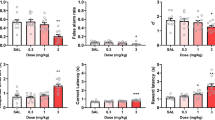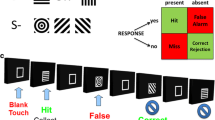Abstract
Rationale
Deficits in memory and attention are broadly acknowledged during psychosis; however, experiments on modeled psychosis often test working memory without systematic manipulation of attentional demands.
Objectives
The major research goal was discovering which neurobehavioral processes, attention, or memory contributed more to drug-provoked performance deficits.
Materials and methods
Rats were trained to perform operant ratio discrimination (RD) tasks wherein the number of presses at a rear-wall lever was discriminated using one of two front-wall levers. Effects from four psychotomimetic drugs, the serotonin agonist 2,5-dimethoxy-4-iodoamphetamine, the noncompetitive NMDA-glutamate receptor antagonist phencyclidine (PCP), and two CB1-selective cannabinoid agonists, WIN 55,512-2 and AM 411, were assessed using a signal detection analytical overlay to dissociate cognitive from noncognitive motor and motivational disruptions. Further methods allowed dissociation of attention compromises from mnemonic deficits.
Results
For each test compound, at least one dose elicited decreased RD accuracy without affecting response rates, and task difficulty was shown to be a crucial dictator of accuracy effect specificities. Effects from both PCP and WIN 55,512-2 biased animals to select the response lever conditioned for denser reinforcement. The same two drugs rendered peculiar response patterns in distracter light session components, considering light blinks were included to divert subjects’ attention away from task-relevant information. The response patterns determined during distracter components of PCP/WIN testing sessions, counterintuitively, suggest performance enhancement.
Conclusion
Comprehensive viewing of RD performance patterns after drug administration indicates that sustained attention and transient information management are significantly impaired during the drug-induced psychosis state, while selective attention is less affected.





Similar content being viewed by others
References
Aghajanian GK, Marek GJ (1999) Serotonin and hallucinogens. Neuropsychopharmacology 21:16S–23S
Arnold HM, Bruno JP, Sarter M (2003) Assessment of sustained and divided attention in rats. Curr Protoc Neurosci Chapter 8: Unit 8 5E
Baddeley A (1986) Working memory. Oxford, New York
Bell DS (1965) Comparison of amphetamine psychosis and schizophrenia. Br J Psychiatry 111:701–707
Branch M (1974) Behavior as a stimulus: joint effects of d-amphetamine and pentobarbital. J Pharmacol Exp Ther 189:33–41
Burk J (2004) Introduction of a retention interval in a sustained attention task in rats: effects of a visual distracter and increasing the inter-trial interval. Behav Proc 67:521–531
Davies D, Parasuraman R (1982) The psychology of vigilance. Academic, New York
Fenimore DC, Loy PR (1971) Injectible dispersion of delta 9-tetrahydrocannabinol in saline using polyvinylpyrrolidone. J Pharm Pharmacol 23:310
Fetterman JG (1993) Numerosity discrimination: both time and number matter. J Exp Psychol Anim Behav Proc 19:149–164
Fries P, Womelsdorf T, Oostenveld R, Desimone R (2008) The effects of visual stimulation and selective visual attention on rhythmic neuronal synchronization in macaque area V4. J Neurosci 28:4823–4835
Galbicka G, Kautz MA, Jagers T (1994) Behavioral effects of enantiomers of dizocilpine under two “counting” procedures in rats. Pharmacol Biochem Behav 49:943–948
Green MF, Nuechterlein KH, Gaier DJ (1992) Sustained and selective attention in schizophrenia. Prog Exp Pers Psychopathol Res 15:290–313
Hemsley DR (1996) Schizophrenia. A cognitive model and its implications for psychological intervention. Behav Modif 20:139–169
Holzman PS, Levy DL, Proctor LR (1978) The several qualities of attention in schizophrenia. J Psychiatr Res 14:99–110
Huestis MA, Gorelick DA, Heishman SJ, Preston KL, Nelson RA, Moolchan ET, Frank RA (2001) Blockade of effects of smoked marijuana by the CB1-selective cannabinoid receptor antagonist SR141716. Arch Gen Psychiatry 58:322–328
Hulse S, Fowler H, Honig W (1978) Cognitive processes in animal behavior. Earlbaum, Hillsdale
Johns A (2002) From dead drunk to dead drunks—medico-legal aspects of substance misuse, violence and mental illness. Med Leg J 70:108–125
Jones SH, Hemsley DR, Gray JA (1991) Contextual effects on choice reaction time and accuracy in acute and chronic schizophrenics. Impairment in selective attention or in the influence of prior learning? Br J Psychiatry 159:415–421
Kane MJ, Engle RW (2003) Working-memory capacity and the control of attention: the contributions of goal neglect, response competition, and task set to Stroop interference. J Exp Psychol Gen 132:47–70
Kane M, Conway A, Bleckley M, Engle R (2001) A controlled attention view of working memory capacity. J Exp Psychol 130:169–183
Kirk RC, White KG, McNaughton N (1988) Low dose scopolamine affects discriminability but not rate of forgetting in delayed conditional discrimination. Psychopharmacology (Berl) 96:541–546
Luck S, Vecera S (2002) Attention. In: Pashler H, Yantis S (eds) Stephens handbook of experimental psychology. Wiley, New York, pp 235–286
Martin RS, Secchi RL, Sung E, Lemaire M, Bonhaus DW, Hedley LR, Lowe DA (2003) Effects of cannabinoid receptor ligands on psychosis-relevant behavior models in the rat. Psychopharmacology (Berl) 165:128–135
Mathias S, Lubman DI, Hides L (2008) Substance-induced psychosis: a diagnostic conundrum. J Clin Psych 69:358–367
McGaughy J, Sarter M (1995) Behavioral vigilance in rats: task validation and effects of age, amphetamine, and benzodiazepine receptor ligands. Psychopharmacology (Berl) 117:340–357
McQuail JA, Burk JA (2006) Evaluation of muscarinic and nicotinic receptor antagonists on attention and working memory. Pharmacol Biochem Behav 85:796–803
Mechner F, Guevrekian L (1962) Effects of deprivation upon counting and timing in rats. J Exp Anal Behav 5:463
Moerschbaecher JM, Mastropaolo J, Winsauer PJ, Thompson DM (1984) Effects of opioids on accuracy of a fixed-ratio discrimination in monkeys and rats. J Pharmacol Exp Ther 230:541–549
Moray N (1969) Attention: selective processes in vision and hearing. Academic, New York
Negrete JC (1973) Relative value of various etiological factors in short lasting, adverse psychological reactions to cannabis smoking. Br J Addict Alcohol Other Drugs 68:221–229
Platt JR (1973) Percentile reinforcement: paradigms for experimental analysis of response shaping. In: Bower GH (ed) The psychology of learning and motivation. Academic, New York, pp 271–296
Poorheidari G, Stanhope KJ, Pratt JA (1998) Effects of the potassium channel blockers, apamin and 4-aminopyridine, on scopolamine-induced deficits in the delayed matching to position task in rats: a comparison with the cholinesterase inhibitor E2020. Psychopharmacology (Berl) 135:242–255
Posner M, Snyder C (1975) Attention and cognitive control. In: Solso R (ed) Information processing in cognition: The Loyola Symposium. Erlbaum, Hillsdale, pp 55–85
Rosenberg J, Woods J (1975) Effects of pentobarbial on fixed ratio discrimination. Bull Psych Soc 5:33–35
Sipes TA, Geyer MA (1994) Multiple serotonin receptor subtypes modulate prepulse inhibition of the startle response in rats. Neuropharmacology 33:441–448
Skosnik PD, Spatz-Glenn L, Park S (2001) Cannabis use is associated with schizotypy and attentional disinhibition. Schizophr Res 48:83–92
Solowij N, Michie PT (2007) Cannabis and cognitive dysfunction: parallels with endophenotypes of schizophrenia? J Psychiatry Neurosci 32:30–52
Stanhope KJ, McLenachan AP, Dourish CT (1995) Dissociation between cognitive and motor/motivational deficits in the delayed matching to position test: effects of scopolamine, 8-OH-DPAT and EAA antagonists. Psychopharmacology (Berl) 122:268–280
Tan S, Kirk RC, Abraham WC, McNaughton N (1989) Effects of the NMDA antagonists CPP and MK-801 on delayed conditional discrimination. Psychopharmacology (Berl) 98:556–560
Watson JE, Blampied NM (1989) Quantification of the effects of chlorpromazine on performance under delayed matching to sample in pigeons. J Exp Anal Behav 51:317–328
White K, Alsop G (1993) Cognition in birds. In: Saghal A (ed) Behavioral neuroscience, a practical approach. Oxford University Press, London, pp 137–147
White KG, McCarthy D, Fantino E (1989) Cognition and behavior analysis. J Exp Anal Behav 52:197–198
Willmore CB (2003) The cognitive effect profiles of NMDA receptor modulating drugs are resolvable if stimulus complexity is varied in a number discernment task. Behav Cogn Neurosci Rev 2:130–147
Willmore CB, Bespalov AY, Beardsley PM (2002) Site-selective N-methyl-D-aspartate and alpha-amino-3-hydroxy-5-methyl-4-isoxazolepropionate antagonists produce distinct effects in rats performing complex discriminations. Neurobiol Learn Mem 78:347–364
Yui K, Ikemoto S, Ishiguro T, Goto K (2000) Studies of amphetamine or methamphetamine psychosis in Japan: relation of methamphetamine psychosis to schizophrenia. Ann N Y Acad Sci 914:1–12
Author information
Authors and Affiliations
Corresponding author
Additional information
The authors extend thanks to J. Edward Moreton, Ph.D., for the University of Maryland School of Pharmacy, for technical and conceptual contributions to this research effort.
Rights and permissions
About this article
Cite this article
Willmore, C.B., Krall, D.M., Spears, F.M. et al. Cognitive effects of psychotomimetic drugs in rats discriminating number cues. Psychopharmacology 206, 653–664 (2009). https://doi.org/10.1007/s00213-008-1339-9
Received:
Accepted:
Published:
Issue Date:
DOI: https://doi.org/10.1007/s00213-008-1339-9




